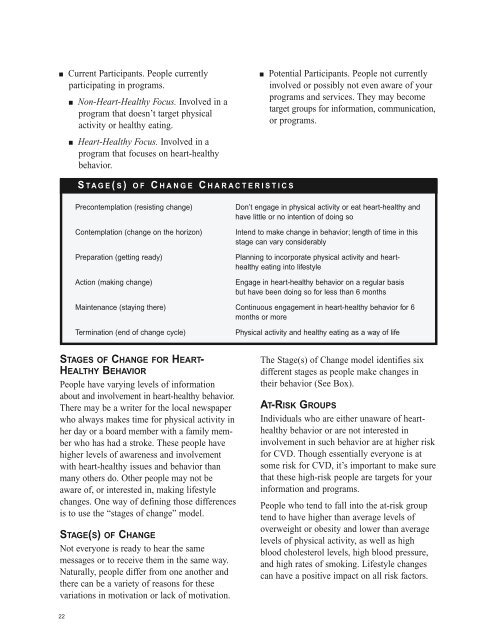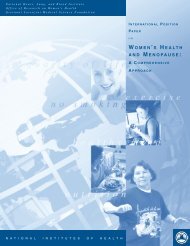HeartsNParks Community Mobilization Guide - National Heart, Lung ...
HeartsNParks Community Mobilization Guide - National Heart, Lung ...
HeartsNParks Community Mobilization Guide - National Heart, Lung ...
You also want an ePaper? Increase the reach of your titles
YUMPU automatically turns print PDFs into web optimized ePapers that Google loves.
■ Current Participants. People currently<br />
participating in programs.<br />
22<br />
■ Non-<strong>Heart</strong>-Healthy Focus. Involved in a<br />
program that doesn’t target physical<br />
activity or healthy eating.<br />
■ <strong>Heart</strong>-Healthy Focus. Involved in a<br />
program that focuses on heart-healthy<br />
behavior.<br />
S TAGE( S ) OF C HANGE C HARACTERISTICS<br />
■ Potential Participants. People not currently<br />
involved or possibly not even aware of your<br />
programs and services. They may become<br />
target groups for information, communication,<br />
or programs.<br />
Precontemplation (resisting change) Don’t engage in physical activity or eat heart-healthy and<br />
have little or no intention of doing so<br />
Contemplation (change on the horizon) Intend to make change in behavior; length of time in this<br />
stage can vary considerably<br />
Preparation (getting ready) Planning to incorporate physical activity and hearthealthy<br />
eating into lifestyle<br />
Action (making change) Engage in heart-healthy behavior on a regular basis<br />
but have been doing so for less than 6 months<br />
Maintenance (staying there) Continuous engagement in heart-healthy behavior for 6<br />
months or more<br />
Termination (end of change cycle) Physical activity and healthy eating as a way of life<br />
STAGES OF CHANGE FOR HEART-<br />
HEALTHY BEHAVIOR<br />
People have varying levels of information<br />
about and involvement in heart-healthy behavior.<br />
There may be a writer for the local newspaper<br />
who always makes time for physical activity in<br />
her day or a board member with a family member<br />
who has had a stroke. These people have<br />
higher levels of awareness and involvement<br />
with heart-healthy issues and behavior than<br />
many others do. Other people may not be<br />
aware of, or interested in, making lifestyle<br />
changes. One way of defining those differences<br />
is to use the “stages of change” model.<br />
STAGE(S) OF CHANGE<br />
Not everyone is ready to hear the same<br />
messages or to receive them in the same way.<br />
Naturally, people differ from one another and<br />
there can be a variety of reasons for these<br />
variations in motivation or lack of motivation.<br />
The Stage(s) of Change model identifies six<br />
different stages as people make changes in<br />
their behavior (See Box).<br />
AT-RISK GROUPS<br />
Individuals who are either unaware of hearthealthy<br />
behavior or are not interested in<br />
involvement in such behavior are at higher risk<br />
for CVD. Though essentially everyone is at<br />
some risk for CVD, it’s important to make sure<br />
that these high-risk people are targets for your<br />
information and programs.<br />
People who tend to fall into the at-risk group<br />
tend to have higher than average levels of<br />
overweight or obesity and lower than average<br />
levels of physical activity, as well as high<br />
blood cholesterol levels, high blood pressure,<br />
and high rates of smoking. Lifestyle changes<br />
can have a positive impact on all risk factors.
















